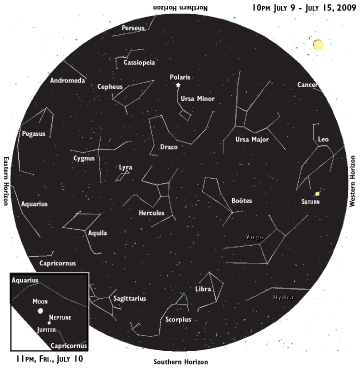
Volume XVII, Issue 28 # July 9 - July 15, 2009 |
 |
 |
Sky Watch
by J. Alex Knoll
Out of Sight
Let Jupiter help you find distant Neptune
The waning gibbous moon rises at 10pm Thursday, with Jupiter following less than 10 degrees behind. The next evening, the moon falls back almost 30 minutes and now trails Jupiter by less than five degrees.
Jupiter has another traveling companion, although you’ll need a telescope to spot it. Train your scope on Jupiter and look one-half degree above it for a tiny blue-green light, Neptune, the outermost planet since Pluto was demoted.
At almost three billion miles distant, Neptune was not discovered until 1846. What little we know of the planet comes from the 1989 fly-by of the Voyager II spacecraft and more recently from the Hubble Space Telescope. Neptune has an outer atmosphere several thousand miles deep made up primarily of hydrogen, helium and methane. These gases furiously circle the planet at more than 1,250 miles an hour, the fastest winds known in the entire solar system. Oddly enough, they blow counter to Neptune’s own rotation.
Beneath the Neptune’s clouds is a relatively warm ocean composed of water, ammonia and methane. Recent discoveries of life deep beneath earth’s own oceans around ammonia- and methane-belching thermal vents have led scientists to posit that Neptune’s ocean could perhaps give rise to life.
Our nearest planetary neighbors, Venus and Mars, rise in the east-northeast in the wee hours of the morning, with the morning star trailing the red planet by a little more than seven degrees at week’s end. Venus is truly dazzling, shining 130 times brighter than Mars. Reddish Aldebaran shines to the other side of Venus. Each night the two planets appear a little farther apart, with Venus pulling within a few degrees of the blazing eye of the bull Sunday and Monday.
Illustration: © Copyright 1925 M.C. Escher/Cordon Art-Baarn-Holland; Graphics: © Copyright 2009 Pacific Publishers. Reprinted by permission from the Tidelog graphic almanac. Bound copies of the annual Tidelog for Chesapeake Bay are $14.95 ppd. from Pacific Publishers, Box 480, Bolinas, CA 94924. Phone 415-868-2909. Weather affects tides. This information is believed to be reliable but no guarantee of accuracy is made by Bay Weekly or Pacific Publishers. The actual layout of Tidelog differs from that used in Bay Weekly. Tidelog graphics are repositioned to reflect Bay Weekly’s distribution cycle.Tides are based on National Oceanic and Atmospheric Administration and are positioned to coincide with high and low tides of Tidelog.
